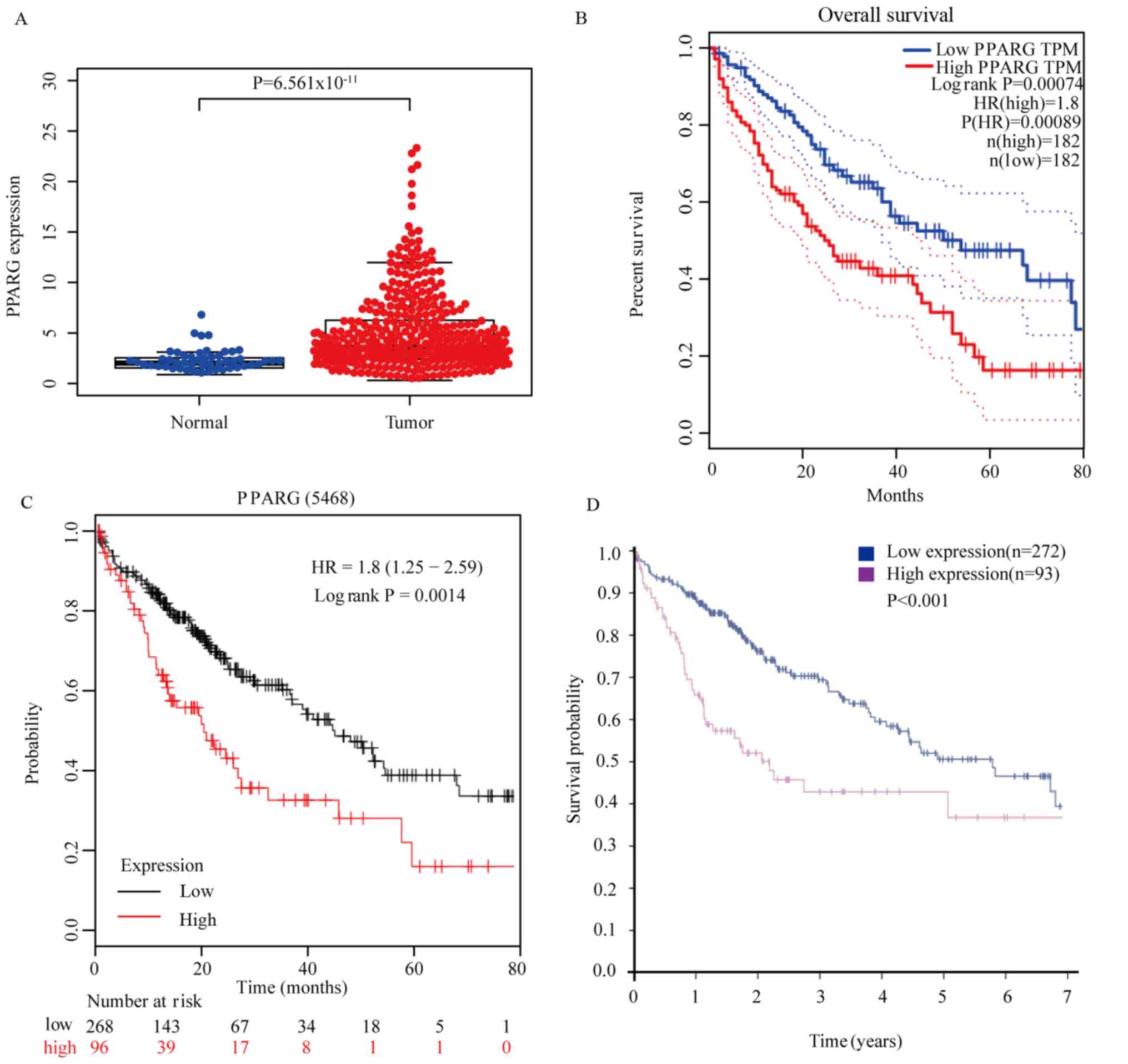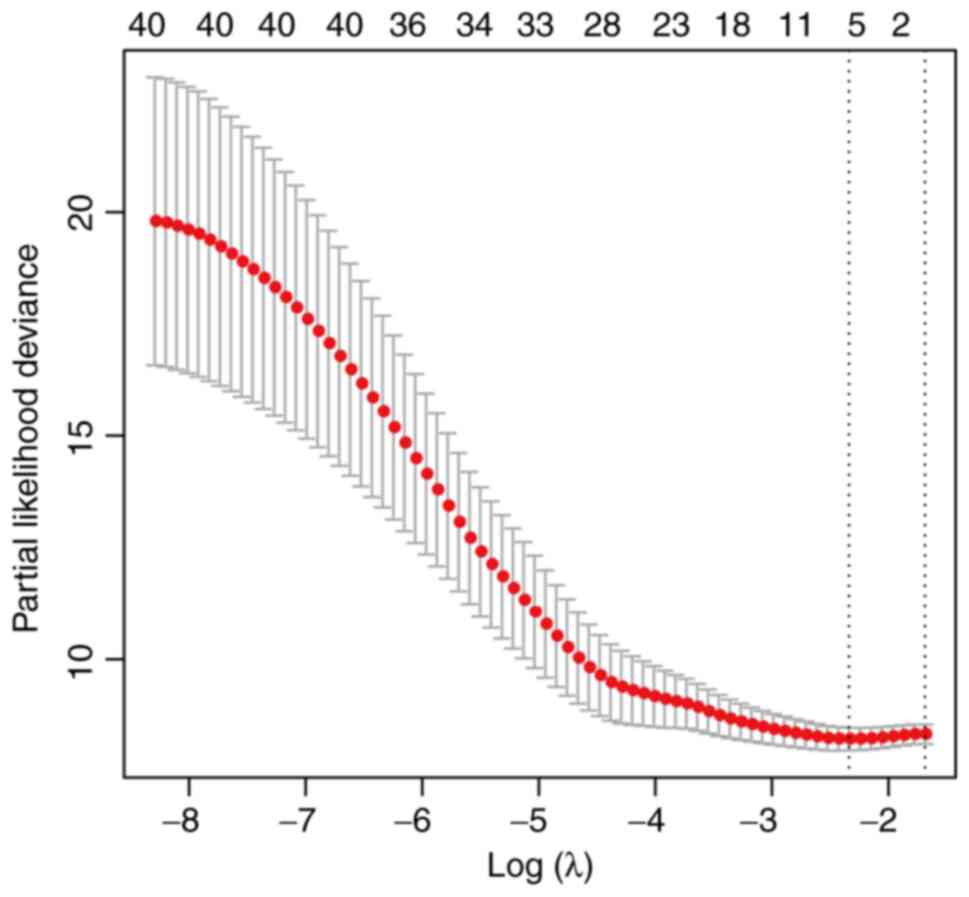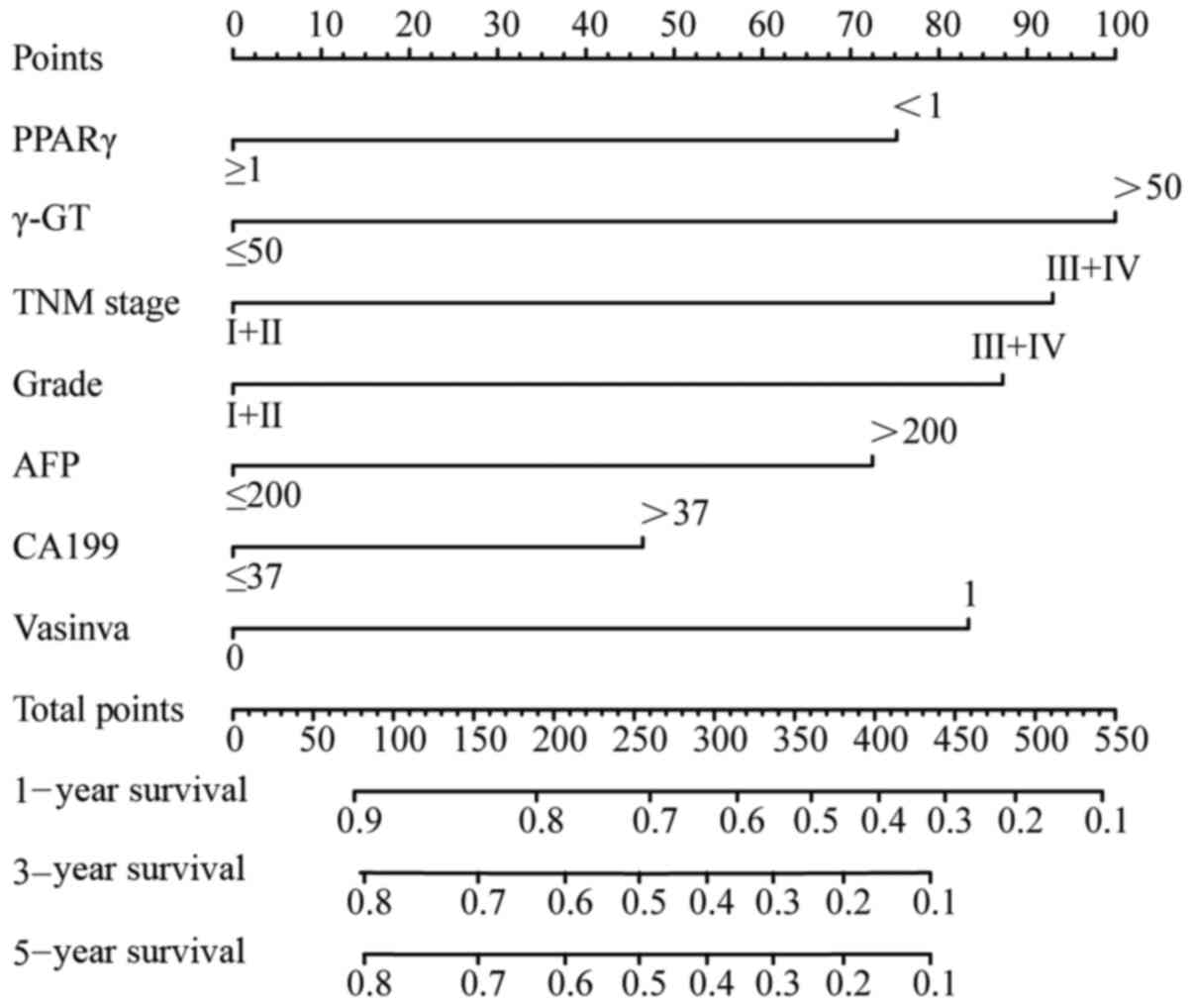|
1
|
Baffy G, Brunt EM and Caldwell SH:
Hepatocellular carcinoma in non-alcoholic fatty liver disease: an
emerging menace. J Hepatol. 56:1384–1391. 2012. View Article : Google Scholar : PubMed/NCBI
|
|
2
|
Bray F, Ferlay J, Soerjomataram I, Siegel
RL, Torre LA and Jemal A: Global cancer statistics 2018: GLOBOCAN
estimates of incidence and mortality worldwide for 36 cancers in
185 countries. CA Cancer J Clin. 68:394–424. 2018. View Article : Google Scholar : PubMed/NCBI
|
|
3
|
El-Serag HB, Marrero JA, Rudolph L and
Reddy KR: Diagnosis and treatment of hepatocellular carcinoma.
Gastroenterology. 134:1752–1763. 2008. View Article : Google Scholar : PubMed/NCBI
|
|
4
|
Roayaie S, Obeidat K, Sposito C, Mariani
L, Bhoori S, Pellegrinelli A, Labow D, Llovet JM, Schwartz M and
Mazzaferro V: Resection of hepatocellular cancer ≤2 cm: Results
from two Western centers. Hepatology. 57:1426–1435. 2013.
View Article : Google Scholar : PubMed/NCBI
|
|
5
|
Forner A, Reig M and Bruix J:
Hepatocellular carcinoma. Lancet. 391:1301–1314. 2018. View Article : Google Scholar : PubMed/NCBI
|
|
6
|
Yousefnia S, Momenzadeh S, Seyed Forootan
F, Ghaedi K and Esfahani MH: The influence of peroxisome
proliferator-activated receptor γ (PPARγ) ligands on cancer cell
tumorigenicity. Gene. 649:14–22. 2018. View Article : Google Scholar : PubMed/NCBI
|
|
7
|
Li S, Yang B, Du Y, Lin Y, Liu J, Huang S,
Zhang A, Jia Z and Zhang Y: Targeting PPARα for the treatment and
understanding of cardiovascular diseases. Cell Physiol Biochem.
51:2760–2775. 2018. View Article : Google Scholar : PubMed/NCBI
|
|
8
|
Magadum A and Engel FB: PPARβ/δ: Linking
metabolism to regeneration. Int J Mol Sci. 19:20132018. View Article : Google Scholar
|
|
9
|
Lehrke M and Lazar MA: The many faces of
PPARgamma. Cell. 123:993–999. 2005. View Article : Google Scholar : PubMed/NCBI
|
|
10
|
Skat-Rørdam J, Højland Ipsen D,
Lykkesfeldt J and Tveden-Nyborg P: A role of peroxisome
proliferator-activated receptor γ in non-alcoholic fatty liver
disease. Basic Clin Pharmacol Toxicol. 124:528–537. 2019.
View Article : Google Scholar : PubMed/NCBI
|
|
11
|
Hsu HT and Chi CW: Emerging role of the
peroxisome proliferator-activated receptor-gamma in hepatocellular
carcinoma. J Hepatocell Carcinoma. 1:127–135. 2014.PubMed/NCBI
|
|
12
|
Lee YH, Seo D, Choi KJ, Andersen JB, Won
MA, Kitade M, Gómez-Quiroz LE, Judge AD, Marquardt JU, Raggi C, et
al: Antitumor effects in hepatocarcinoma of isoform-selective
inhibition of HDAC2. Cancer Res. 74:4752–4761. 2014. View Article : Google Scholar : PubMed/NCBI
|
|
13
|
Giannini EG, Aglitti A, Borzio M, Gambato
M, Guarino M, Iavarone M, Lai Q, Levi Sandri GB, Melandro F,
Morisco F, et al: Overview of immune checkpoint inhibitors therapy
for hepatocellular carcinoma, and The ITA.LI.CA cohort derived
estimate of amenability rate to immune checkpoint inhibitors in
clinical practice. Cancers (Basel). 11:16892019. View Article : Google Scholar
|
|
14
|
Anstee QM, Reeves HL, Kotsiliti E, Govaere
O and Heikenwalder M: From NASH to HCC: Current concepts and future
challenges. Nat Rev Gastroenterol Hepatol. 16:411–428. 2019.
View Article : Google Scholar : PubMed/NCBI
|
|
15
|
Choudhary NS, Kumar N and Duseja A:
Peroxisome proliferator-activated receptors and their agonists in
nonalcoholic fatty liver disease. J Clin Exp Hepatol. 9:731–739.
2019. View Article : Google Scholar : PubMed/NCBI
|
|
16
|
Westerbacka J, Kolak M, Kiviluoto T,
Arkkila P, Sirén J, Hamsten A, Fisher RM and Yki-Järvinen H: Genes
involved in fatty acid partitioning and binding, lipolysis,
monocyte/macrophage recruitment, and inflammation are overexpressed
in the human fatty liver of insulin-resistant subjects. Diabetes.
56:2759–2765. 2007. View Article : Google Scholar : PubMed/NCBI
|
|
17
|
Tanaka N, Aoyama T, Kimura S and Gonzalez
FJ: Targeting nuclear receptors for the treatment of fatty liver
disease. Pharmacol Ther. 179:142–157. 2017. View Article : Google Scholar : PubMed/NCBI
|
|
18
|
Feng X, Yu W, Li X, Zhou F, Zhang W, Shen
Q, Li J, Zhang C and Shen P: Apigenin, a modulator of PPARγ,
attenuates HFD-induced NAFLD by regulating hepatocyte lipid
metabolism and oxidative stress via Nrf2 activation. Biochem
Pharmacol. 136:136–149. 2017. View Article : Google Scholar : PubMed/NCBI
|
|
19
|
Samuel VT and Shulman GI: Nonalcoholic
fatty liver disease as a nexus of metabolic and hepatic diseases.
Cell Metab. 27:22–41. 2018. View Article : Google Scholar : PubMed/NCBI
|
|
20
|
Silva AKS and Peixoto CA: Role of
peroxisome proliferator- activated receptors in non-alcoholic fatty
liver disease inflammation. Cell Mol Life Sci. 75:2951–2961. 2018.
View Article : Google Scholar : PubMed/NCBI
|
|
21
|
Gao M, Ma Y, Alsaggar M and Liu D: Dual
outcomes of rosiglitazone treatment on fatty liver. AAPS J.
18:1023–1031. 2016. View Article : Google Scholar : PubMed/NCBI
|
|
22
|
Yang SJ, Choi JM, Chae SW, Kim WJ, Park
SE, Rhee EJ, Lee WY, Oh KW, Park SW, Kim SW and Park CY: Activation
of peroxisome proliferator-activated receptor gamma by
rosiglitazone increases sirt6 expression and ameliorates hepatic
steatosis in rats. PLoS One. 6:e170572011. View Article : Google Scholar : PubMed/NCBI
|
|
23
|
Yu S, Matsusue K, Kashireddy P, Cao WQ,
Yeldandi V, Yeldandi AV, Rao MS, Gonzalez FJ and Reddy JK:
Adipocyte-specific gene expression and adipogenic steatosis in the
mouse liver due to peroxisome proliferator-activated receptor
gamma1 (PPARgamma1) overexpression. J Biol Chem. 278:498–505. 2003.
View Article : Google Scholar : PubMed/NCBI
|
|
24
|
Feng J, Dai W, Mao Y, Wu L, Li J, Chen K,
Yu Q, Kong R, Li S, Zhang J, et al: Simvastatin re-sensitizes
hepatocellular carcinoma cells to sorafenib by inhibiting
HIF-1α/PPAR-γ/PKM2-mediated glycolysis. J Exp Clin Cancer Res.
39:242020. View Article : Google Scholar : PubMed/NCBI
|
|
25
|
Piccinin E, Villani G and Moschetta A:
Metabolic aspects in NAFLD, NASH and hepatocellular carcinoma: The
role of PGC1 coactivators. Nat Rev Gastroenterol Hepatol.
16:160–174. 2019. View Article : Google Scholar : PubMed/NCBI
|
|
26
|
Shu Y, Lu Y, Pang X, Zheng W, Huang Y, Li
J, Ji J, Zhang C and Shen P: Phosphorylation of PPARγ at Ser84
promotes glycolysis and cell proliferation in hepatocellular
carcinoma by targeting PFKFB4. Oncotarget. 7:76984–76994. 2016.
View Article : Google Scholar : PubMed/NCBI
|
|
27
|
Ritchie ME, Phipson B, Wu D, Hu Y, Law CW,
Shi W and Smyth GK: limma powers differential expression analyses
for RNA-sequencing and microarray studies. Nucleic Acids Res.
43:e472015. View Article : Google Scholar : PubMed/NCBI
|
|
28
|
Tang Z, Li C, Kang B, Gao G, Li C and
Zhang Z: GEPIA: A web server for cancer and normal gene expression
profiling and interactive analyses. Nucleic Acids Res. 45((W1)):
W98–W102. 2017. View Article : Google Scholar : PubMed/NCBI
|
|
29
|
Hou GX, Liu P, Yang J and Wen S: Mining
expression and prognosis of topoisomerase isoforms in
non-small-cell lung cancer by using Oncomine and Kaplan-Meier
plotter. PLoS One. 12:e01745152017. View Article : Google Scholar : PubMed/NCBI
|
|
30
|
Subramanian A, Tamayo P, Mootha VK,
Mukherjee S, Ebert BL, Gillette MA, Paulovich A, Pomeroy SL, Golub
TR, Lander ES and Mesirov JP: Gene set enrichment analysis: A
knowledge-based approach for interpreting genome-wide expression
profiles. Proc Natl Acad Sci USA. 102:15545–15550. 2005. View Article : Google Scholar : PubMed/NCBI
|
|
31
|
Ogata H, Goto S, Sato K, Fujibuchi W, Bono
H and Kanehisa M: KEGG: Kyoto encyclopedia of genes and genomes.
Nucleic acids Res. 27:29–34. 1999. View Article : Google Scholar : PubMed/NCBI
|
|
32
|
R Core Team: R: A language and environment
for statistical computing. R Foundation for Statistical Computing;
Vienna, Austria: ISBN 3-900051-07-0, 2012. http://www.R-project.org/
|
|
33
|
Bierley JD, Gospodarowicz MK and Wittekind
C: The TNM classification of malignant tumours. 8th edition.
Oxford: Wiley, Blackwell; 2017
|
|
34
|
Friedman J, Hastie T and Tibshirani R:
Regularization paths for generalized linear models via coordinate
descent. J Stat Softw. 33:1–22. 2010. View Article : Google Scholar : PubMed/NCBI
|
|
35
|
Chen S, Dong Z, Yang P, Wang X, Jin G, Yu
H, Chen L, Li L, Tang L, Bai S, et al: Hepatitis B virus X protein
stimulates high mobility group box 1 secretion and enhances
hepatocellular carcinoma metastasis. Cancer Lett. 394:22–32. 2017.
View Article : Google Scholar : PubMed/NCBI
|
|
36
|
Nojima H, Kuboki S, Shinoda K, Shimizu H,
Ohtsuka M, Kato A, Yoshitomi H, Furukawa K, Takayashiki T and
Miyazaki M: Activation of peroxisome proliferator-activated
receptor-gamma inhibits tumor growth by negatively regulating
nuclear factor-κB activation in patients with hepatocellular
carcinoma. J Hepatobiliary Pancreat Sci. 23:574–584. 2016.
View Article : Google Scholar : PubMed/NCBI
|
|
37
|
Cervello M, Emma MR, Augello G, Cusimano
A, Giannitrapani L, Soresi M, Akula SM, Abrams SL, Steelman LS,
Gulino A, et al: New landscapes and horizons in hepatocellular
carcinoma therapy. Aging (Albany NY). 12:3053–3094. 2020.
View Article : Google Scholar : PubMed/NCBI
|
|
38
|
Xu Z, Meng SH, Bai JG, Sun C, Zhao LL,
Tang RF, Yin ZL, Ji JW, Yang W and Ma GJ: C/EBPα regulates FOXC1 to
modulate tumor growth by interacting with PPARγ in hepatocellular
carcinoma. Curr Cancer Drug Targets. 20:59–66. 2020. View Article : Google Scholar : PubMed/NCBI
|
|
39
|
Tan J, Shen W, Shi W, Chen X, Sun D, Xu C,
Yan Q, Cheng H, Lai Y and Ji H: ONTD induces growth arrest and
apoptosis of human hepatoma Bel-7402 cells though a peroxisome
proliferator-activated receptor γ-dependent pathway. Toxicol In
Vitro. 45:44–53. 2017. View Article : Google Scholar : PubMed/NCBI
|
|
40
|
Schaefer KL, Wada K, Takahashi H,
Matsuhashi N, Ohnishi S, Wolfe MM, Turner JR, Nakajima A, Borkan SC
and Saubermann LJ: Peroxisome proliferator-activated receptor gamma
inhibition prevents adhesion to the extracellular matrix and
induces anoikis in hepatocellular carcinoma cells. Cancer Res.
65:2251–2259. 2005. View Article : Google Scholar : PubMed/NCBI
|
|
41
|
Yu J, Shen B, Chu ES, Teoh N, Cheung KF,
Wu CW, Wang S, Lam CN, Feng H, Zhao J, et al: Inhibitory role of
peroxisome proliferator-activated receptor gamma in
hepatocarcinogenesis in mice and in vitro. Hepatology.
51:2008–2019. 2010. View Article : Google Scholar : PubMed/NCBI
|
|
42
|
Koga H, Sakisaka S, Harada M, Takagi T,
Hanada S, Taniguchi E, Kawaguchi T, Sasatomi K, Kimura R, Hashimoto
O, et al: Involvement of p21(WAF1/Cip1), p27(Kip1), and p18(INK4c)
in troglitazone-induced cell-cycle arrest in human hepatoma cell
lines. Hepatology. 33:1087–1097. 2001. View Article : Google Scholar : PubMed/NCBI
|
|
43
|
Yu J, Qiao L, Zimmermann L, Ebert MP,
Zhang H, Lin W, Röcken C, Malfertheiner P and Farrell GC:
Troglitazone inhibits tumor growth in hepatocellular carcinoma in
vitro and in vivo. Hepatology. 43:134–143. 2006. View Article : Google Scholar : PubMed/NCBI
|
|
44
|
Wu CW, Farrell GC and Yu J: Functional
role of peroxisome-proliferator-activated receptor gamma in
hepatocellular carcinoma. J Gastroenterol Hepatol. 27:1665–1669.
2012. View Article : Google Scholar : PubMed/NCBI
|
|
45
|
Cao LQ, Shao ZL, Liang HH, Zhang DW, Yang
XW, Jiang XF and Xue P: Activation of peroxisome
proliferator-activated receptor-γ (PPARγ) inhibits hepatoma cell
growth via downregulation of SEPT2 expression. Cancer Lett.
359:127–135. 2015. View Article : Google Scholar : PubMed/NCBI
|
|
46
|
Lee HJ, Su Y, Yin PH, Lee HC and Chi CW:
PPAR(gamma)/PGC-1(alpha) pathway in E-cadherin expression and
motility of HepG2 cells. Anticancer Res. 29:5057–5063.
2009.PubMed/NCBI
|
|
47
|
Hsu HT, Sung MT, Lee CC, Kuo YJ, Chi CW,
Lee HC and Hsia CY: Peroxisome proliferator-activated receptor γ
expression is inversely associated with macroscopic vascular
invasion in human hepatocellular carcinoma. Int J Mol Sci.
17:12262016. View Article : Google Scholar
|
|
48
|
Han M, Gao H, Ju P, Gao MQ, Yuan YP, Chen
XH, Liu KL, Han YT and Han ZW: Hispidulin inhibits hepatocellular
carcinoma growth and metastasis through AMPK and ERK signaling
mediated activation of PPARγ. Biomed Pharmacother. 103:272–283.
2018. View Article : Google Scholar : PubMed/NCBI
|
|
49
|
Lin L, Yan L, Liu Y, Qu C, Ni J and Li H:
The burden and trends of primary liver cancer caused by specific
etiologies from 1990 to 2017 at the global, regional, national,
age, and sex level results from the global burden of disease study
2017. Liver Cancer. 9:563–582. 2020. View Article : Google Scholar : PubMed/NCBI
|
|
50
|
Singal AG, Lampertico P and Nahon P:
Epidemiology and surveillance for hepatocellular carcinoma: New
trends. J Hepatol. 72:250–261. 2020. View Article : Google Scholar : PubMed/NCBI
|
|
51
|
Oliveros E, Somers VK, Sochor O, Goel K
and Lopez-Jimenez F: The concept of normal weight obesity. Prog
Cardiovasc Dis. 56:426–433. 2014. View Article : Google Scholar : PubMed/NCBI
|
|
52
|
Tu Q, Hu C, Zhang H, Peng C, Kong M, Song
M, Zhao C, Wang Y, Li J, Zhou C, et al: Establishment and
validation of novel clinical prognosis nomograms for luminal a
breast cancer patients with bone metastasis. Biomed Res Int.
2020:19720642020. View Article : Google Scholar : PubMed/NCBI
|
|
53
|
Zhang X, Yuan K, Wang H, Gong P, Jiang T,
Xie Y, Sheng L, Liu D, Liu X and Xu G: Nomogram to predict
mortality of endovascular thrombectomy for ischemic stroke despite
successful recanalization. J Am Heart Assoc. 9:e0148992020.
View Article : Google Scholar : PubMed/NCBI
|
|
54
|
Bookman MA: Can we predict who lives long
with ovarian cancer? Cancer. 125 (Suppl 24):S4578–S4581. 2019.
View Article : Google Scholar
|

















